#first astronomical velocity
Explore tagged Tumblr posts
Text

First Astronomical Velocity / Super Sonico Collection Volume 1 vinyl release from Very Ok Vinyl announced, featuring new art by Tsuji Santa. (source)
#i wonder when was the last time santa drew suzu and fuuri before this#first astronomical velocity#super sonico#art#news#i do need this however. and i DO own a record player.#fuuri watanuki#suzu fujimi
12 notes
·
View notes
Text
︶︶︶︶︶︶꒦꒷♡꒷꒦︶︶︶︶︶︶ˋ°•*⁀➷Super sonico!!🩷🎀🌸 ˋ°•*⁀➷ Super pochaco!!💛🍮⭐️
Super sonico and super pochaco are two female characters created by tsuji Santa for the video game company called nitroplus appearing both as the main characters for a music festival of the same company in 2006





She works as a gravure idol as well as the vocalist and guitarist of the fictional band First Astronomical Velocity (第一宇宙速度 Daiichi Uchū Sokudo) along with her friends Suzu and Fuuri. She is prone to sleep in a lot, often requiring help to wake up, and her favorite foods are macarons. Her bandmates refer to her as "Nico".
Sonico plays a heritage cherry red Gibson SG electric guitar with a batwing pickguard and black pickup covers named "Daydream."





#⊹ ⋆꒰ఎ ♡ ໒꒱ ⋆゚⊹#🎀。゚・。゚ᐠ( ᐢ ᵕ ᐢ )ᐟ。゚・。゚🎀#かわいい#harajuku#anime figure#hello kitty#japanese fashion#kawaii#kogal#pinkcore#super sonico#super pochaco#super soniko#weeb girl#weeb#otakugirl#anime collecting#anime and manga#jpop idol#ecchigirl#cute#cutecore#anime#otaku#pastelcore#pink
219 notes
·
View notes
Text
A UNIVERSE WITHOUT DARK MATTER??
Blog#515
Saturday, June 21st, 2025,
Welcome back,
Our current picture of the cosmos is one of an expanding universe governed by gravity, born from a hot beginning and stretched uniformly across vast scales. But this vision only holds together when we invoke mysterious unseen forces—inflation, dark energy, and more. This prevailing cosmological model—also known as the Big Bang or Lambda-CDM (ΛCDM)—has countless problems, but it is mainstream, and almost all the scientific and economic efforts of the community of astrophysicists and theoretical physicists dealing with the question are focused on the search for evidence that can confirm it.

Other models explaining the cosmos—for example those without a Big Bang beginning, without an inflationary period, without energy and dark matter—do not receive the same attention. But if any of them are correct, the cosmos could be very different from the mainstream version we have been taught as dogma.
The existence of dark or invisible matter detectable only through its gravitational influence has been known by astronomers for a long time now.

In 1844, Friedrich Wilhelm Bessel argued that the observed proper motions of the stars Sirius and Procyon could be explained only in terms of the presence of faint companion stars. In 1846, Urbain Jean Joseph Le Verrier and John Couch Adams independently predicted the existence of Neptune based on calculations of the anomalous motions of Uranus. Le Verrier later proposed the existence of the planet Vulcan to explain anomalies in the orbit of Mercury, but he failed on that occasion because the solution was not invisible matter but a change of gravitational laws, as was solved years later by Einstein with General Relativity.

In 1933, Swiss astronomer Fritz Zwicky was studying rich clusters of galaxies—large clusters containing hundreds or thousands of individual galaxies. He applied the virial theorem to calculate how much matter should be present based on the gravitational forces needed to hold these clusters together. There appeared to be about 60 times more matter than could be accounted for by all the visible stars and gas. In 1939, Horace W. Babcock first showed the need for dark matter for an individual galaxy by measuring how fast stars were rotating in the outer regions of the M31 galaxy, also known as Andromeda. The rotational velocity was faster than it should have been based on visible matter. At that time, however, the majority of astronomers were not yet convinced of the need for dark matter haloes in galaxies.
Originally published on https://iai.tv
COMING UP!!
(Wednesday, June 25th, 2025)
"IS THERE A GALAXY WITHOUT DARK MATTER??"
#astronomy#outer space#alternate universe#astrophysics#universe#spacecraft#white universe#space#parallel universe#astrophotography
20 notes
·
View notes
Text
Another "oopsie"
The *sigh*... Death Kebab, did a test fire today.
A single tungsten-alloy round, twenty centimeters in diameter, three meters long, just over two thousand kilos, and accelerated by a 610 kilometer long rail cannon, powered by hundreds of their ridiculous true fusion reactor mini stars.
It is, by a factor of stupid, the most powerful gun, if you can even call it that, ever built. Actually, the most powerful single anything ever built. So far.

Upon ejection, the rod was traveling at 0.842103C at what everyone thought was empty space for billions of light years. Except, the middle moon of this... thing... wasn't aligned perfectly, thus changing the inclination of the midsection by less than 0.002 degrees, which altered the exit trajectory by three one billionths of a degree.
In space, this Human attitude of "eh, close enough" they have for most of their things does not cut it when dealing with literal world ending devices. Which this miscalculation will in just over two hundred years.
Typical redirection and space hazard elimination methods simply can't handle this. It's projected that the projectile will potentially shoot through the planet or eject enough mass out the other side at still impressive velocities, triggering a sort of shotgun scatter effect in countless directions. Or just blow up the planet, we don't know. Simulations, no matter how advanced, can only tell us so much about something that has never happened before.
As members of the Coalition, Humanity has been officially tasked to prevent this senseless destruction under penalty of... we'll figure something out. Again, nobody ever thought someone could accidentally literally blow up a planet, we don't have protocols for this!
It doesn't help the Humans are not showing enough worry about this either. The first thing they did was hyper jump a junked freighter they loaded up with high density alloys and plating and explosives in front of the round. Fuck all that did except a giant explosion. Maybe slowed it down by a few hundred km/s, and potentially changed its course?
It is quite hard to track a thing going so fast when it's not within a star system. Nobody has managed to establish a monitoring network throughout all of empty space, some of our ancient civilizations tried - astronomical waste of time and resources, a logistical nightmare, bare cosmic radiation meant constant maintenance, zero use. Except now, for a thing Humans did.
Oh, their next plan is to shoot a smaller round AT the first one and obliterate them both. Sure? We guess it can't get wor-
They're gonna accidentally figure out a way to make this worse, aren't they?
#humans are space oddities#humans are space orcs#humans are deathworlders#humans are space australians#humanity fuck yeah#space gun#shitty art#diagram#death kebab#carionto
198 notes
·
View notes
Text

Distant super-massive black hole shows high velocity sign of over-eating
University of Leicester scientists describe how the capture of new matter formed a ring around the black hole, before being partly swallowed by the hole, with excess matter ejected as a high velocity wind
A new University of Leicester study shows how the uncontrolled growth of a distant Supermassive Black Hole (SMBH) is revealed by the ejection of excess matter as a high velocity wind.
Published in Monthly Notices of the Royal Astronomical Society (MNRAS), it describes for the first time how the black hole’s ‘over-eating’ of new matter led to the excess being ejected at nearly a third of the speed of light.
Powerful outflows of ionized gas have been a major interest of ESA’s XMM-Newton X-ray Observatory since first detected by Leicester X-ray astronomers in 2001, and subsequently recognized as a characteristic feature of luminous AGN.
A black hole is formed when a quantity of matter is confined in a sufficiently small region that its gravitational pull is so strong that nothing - not even light – can escape. The size of a black hole scales with its mass, being 3km in radius for a solar mass hole.
Real – astrophysical - black holes of stellar mass are common throughout the Galaxy, often resulting from the violent collapse of a massive star, while a supermassive black holes (SMBH) may lurk in the nucleus of all but the smallest external galaxies.
University of Leicester scientists conducted a 5-week study of an SMBH in the distant Seyfert galaxy PG1211+143 in 2014, about 1.2 billion light years away, using the ESA’s XMM-Newton Observatory, finding a counter-intuitive inflow that added at least 10 Earth masses to the black hole’s vicinity (MN 2018), with a ring of matter accumulating around the black hole being subsequently identified by its gravitational redshift (MN 2024).
The final part of this story now reports a powerful new outflow at 0.27 times the speed of light, launched a few days later, as gravitational energy released as the ring is drawn towards the hole heats the matter to several million degrees, with radiation pressure driving off any excess.
Professor Ken Pounds from the University of Leicester School of Physics and Astronomy, lead author of the three papers, commented: “Establishing the direct causal link between massive, transient inflow and the resulting outflow offers the fascinating prospect of watching a SMBH grow by regular monitoring of the hot, relativistic winds associated with the accretion of new matter.”
PG1211+143 was a target of University of Leicester X-ray astronomers, using the ESA’s XMM-Newton Observatory, from its launch in December 1999. An early surprise was detecting a fast-moving, counter-intuitive outflow, with a velocity 15% of light (0.15c), and the power to disrupt star formation (and hence growth) in the host galaxy. Later observations found such winds to be a common property of luminous AGN.
The availability of simultaneous ultra-violet fluxes from the Neil Gehrels Swift Observatory, a NASA mission which Leicester hosts the UK Swift Science Data Centre for, was – and will remain - critical in understanding the accretion process in SMBH.

Broad-band spectra from the XMM–Newton pn camera for orbits 2659 (black), 2661 (red), 2663 (green), and 2664 (blue) plotted as a ratio to that of orbit 2652, illustrating strong soft X-ray absorption during the transient line-of-sight inflow on day 16, and then falling while the X-ray emission increases – as additional matter is accreted – to a new peak in orbit 2664. Credit: Monthly Notices of the Royal Astronomical Society (2025). DOI: 10.1093/mnras/staf637
9 notes
·
View notes
Note
How did Mellanus invent warp technology?
Was it an independent inventor like Zefram Cochrane? Or was it a government project?
Eaurp Guz here. So, In the 2330s, our species made first contact with the Zaldans, who had a military station on the surface of and orbit around Oldsky, the other habitable planet in our Zwo-Nmu system (Omen's biggest moon, in fact.)
Zaldans only actually visited Mellanus a handful of times iirc, but they brought knowledge of faster than light travel. We had an understanding of Syernit's Theory of Heavy Masses [Ed note: an incomplete piece of General Relativity, itself an incomplete piece of Subspace Field Theory], but it was not able to explain Zaldan spaceflight. Before the Zaldans had left in the late 2330s or 2340 or so, we had a pretty good understanding of Subspace Field Mechanics on paper, and tested against astronomical observations of Zaldan spaceflight and subspace radio astronomy. (Thanks to a Zaldan Military Officer who left behind a communicator watch)
But this is equivalent to, to put it into Earth terms, Alcubierre's metric. Actually inventing the Cochrane drive was a completely different beast for humans, and the Zaldans were tight lipped enough that we just had no clue at all how to actually build one.
The Omen apparition after the Zaldans left was focused on designing missions to explore Oldsky. This was before Economic Standardisation and the formation of United Mellanus, mind, so this was a real space race. (No, not like the one-sided space race of Terran history.) Who could recover what technology, who could understand how disruptors and subspace and warp drive all worked first.
Using artifacts recovered, several different nations tried to build warp drive prototypes. Most failed. The coolest was probably the Arrowhead Initiative's warp ship, which had the reactor and nacelles built into the payload bay of a two-stage spaceplane. It flew twice, but only on test missions with dummy warp drives. First test was low orbital, second test docked to a transfer stage to test how it would handle reentry from escape velocity, as a potential abort scenario in case the warp drive could not be reactivated.
The Economic Standardisation revolution ended up putting a pin in all of that for a bit.
And so the first successful warp drive was a joint project of United Mellanus Space Program. Which, by the way, fun fact, actually predated United Mellanus itself by several years! We unified our space program before we unified as a planet, which is kinda funny and backwards.

Shortly after the flight of the first crewed warp flight--made from a space station module docked to an NTR, a bunch of capacitors radiators, and a warp drive that could do brief bursts of warp-1, the United Federation of Planets arrived. I was one or two years old when that happened, so I don't remember it personally.
This isn't that different from Earth's spaceflight history. In the 2030s, multiple human nations had launched uncrewed warp drive prototypes, and one of them reportedly even managed to break warp 1, and all sorts of private agencies were sticking sublight warp rings and fusion-impulse drives on old interplanetary rockets to try and make interstellar rockets. But the last of the Eugenics Wars put those projects on hold.
I think terrans tend to exaggerate the importance of individual 'great people.' While it's undeniable that the circumstances of Cochrane's flight were pivotal to the formation of the Federation, humans would have invented warp drive sooner or later without him. (And hey, what about all the other physicists who came up with the theoretical background for it! The many thousands of people in those space programs that made the warp prototypes happen. What about Lily Mucking Sloan! She's the one who did most of the systems engineering on the Phoenix!)
I think that's why we call two nacelles and a cubic factor/speed relationship a "Cochrane drive." Even though most other spacefaring aliens will independently invent essentially the same metric and engine design.
Anyway, mellanoids don't tend to think this way, so we can't really point to a single slime who 'invented' the pulsed warp drive.
And, don't let the UMSP hear me say this, but it's not even completely clear whether we truly invented warp drive. I mean, yes, there are key differences in both the theoretical metric and the physical engineering between mellanoid pulsed warp nacelles and Zaldan warp drive, but like. We got the idea from them. Does make me wonder what we would have figured out, maybe 50 or a hundred years later, if Zaldans never colonized Oldsky. There's only a handful of common 'baby civilization's first warp drive' modalities, but we do lots of stuff weird. We do warp drive weird. Could we have discovered something completely new? Oh well. We'll never know.
#Eaurp Guz#Q&A#ask#warp drive#Star Trek#technobabble#treknobabble#worldbuilding#Mellanoid Slime Worldbuilding
14 notes
·
View notes
Text

M100 and the Expanding Universe - January 9th, 1996.
"The distance to the swirling grand design spiral M100 caused quite a stir among astronomers. Many believed that the Hubble Space Telescope's distance measurement to this galaxy accurately calibrated the expansion rate of the Universe. Others believed this distance measurement was misleading. The Universe's expansion rate is usually given as a quantity called "Hubble's constant", a factor dividing well-measured recession velocity of a galaxy to give actual distance. Scientific debate over the value of Hubble's constant has been ongoing since it was first measured by Edwin Hubble in 1929."
51 notes
·
View notes
Text
Apollo Program: Phase A or Apollo A

NASA ID: M-MS-G-102-61 Date: December 4, 1961
"Apollo A was a lighter-weight July 1961 version of the Apollo spacecraft.
Status: Study 1961.

NASA ID: 63-APOLLO-15
It was specifically designed for long-duration operations in space; to conduct re-entry tests at near-parabolic speeds; and then for manned circumlunar missions.
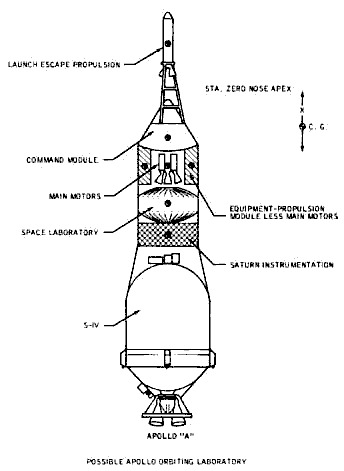
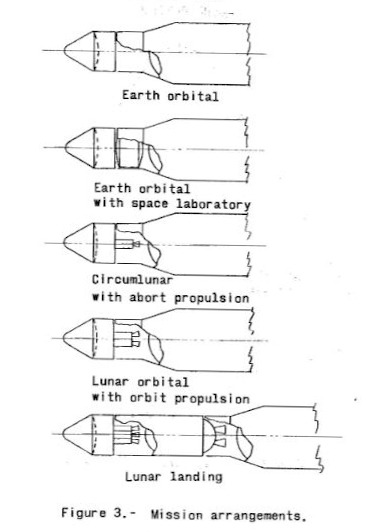
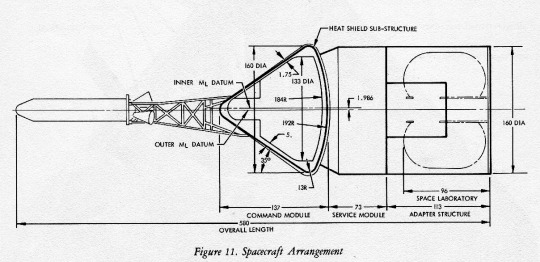
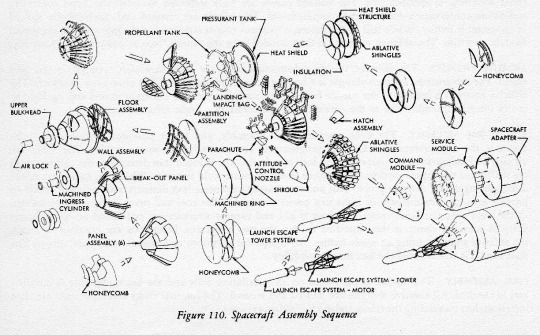
SDASM Archives: Apollo Doc003, Apollo Doc036
At the time of the Apollo bidder's conference in August 1961 an evolutionary approach to the Apollo program was expected. After completion of the Mercury project both the Apollo spacecraft and Saturn launch would gradually fly multi-man crews on a series of ever-more ambitious scientific and technological missions in earth-moon space. This program would begin with manned earth satellite flights of extended lifetime, proceed to lunar circumnavigation, to lunar satellite flights, and ultimately to the lunar landing. Although the Apollo A designation was applied only to the first unmanned Apollo tests at this time, we would use the term here to designate the Apollo design and program plan as envisioned by NASA prior to the Apollo bidder's conference in the summer of 1961.


SDASM Archives: Apollo Doc013, Apollo Doc006
The return to earth and the recovery of the manned spacecraft were important parts of these missions. The development of the Apollo spacecraft was to proceed in several phases. Each phase, to the extent possible, would serve as qualification for the subsequent phase. The objectives of Apollo Phase A was:
Qualification of systems and features for the lunar missions within the constraints or the environment of earth satellite orbits of up to 500 km altitude by manned flights.
Qualification of the re-entry heat protection for the lunar missions in unmanned re-entry tests from super-circular and near-parabolic velocities.
Study of physiological and psychological reactions and capabilities of a multiman crew in the space environment during extended periods of time (at least two weeks). In the adapter between the Saturn second stage and the Apollo spacecraft, as an integral part, was a section to be used as an orbiting laboratory. Preliminary designs indicated this laboratory would be a cylindrical section about 3.9 m in diameter and 2.4 m in height. The laboratory would provide the environment and facilities to conduct scientific experiments related to manned operation of spacecraft. Experiments that might be conducted from an Earth-orbiting laboratory included: astronomical observations; monitoring the Sun's activity; testing man's ability to work outside the vehicle; zero-g testing; and micrometeoroid impact study.
Development of flight and ground operational techniques and equipment for the support of space flights of extended periods
Conduct of experimental investigations as needed to acquire information for the subsequent lunar missions.
The two-stage Saturn C-I launch vehicle system would be utilized to carry the Apollo A spacecraft into the low earth-satellite orbits and to accelerate the capsule only to re-entry trajectories during the Apollo A phase.

The mass breakdown of the Apollo A earth-orbit version was nearly 1/3 less than that of the later Apollo capsule final design:
Command Module: 3600 Kg
Equipment-Propulsion Module (less Main Motors): 1600 kg
Main Motors: 1300 kg
Space Laboratory: 1400 kg
Launch Escape Propulsion: 1700 kg (separated after first stage burn-out)
Total Launch Weight: 9500 kg
Total Weight in Low Earth Orbit: 7800 kg
As of the summer of 1961 it was planned that Apollo A boilerplate flights in the earth-orbit configuration would take place in October/December 1963 using Saturn C-1's SA-7 and SA-8. SA-9 and SA-10 would launch 3400 kg capsule-only payloads in February-April 1964 to near parabolic velocities in tests of the capsule's hypersonic aerodynamics and heat shield. These prototype capsules would be equipped with parachutes and be recovered.
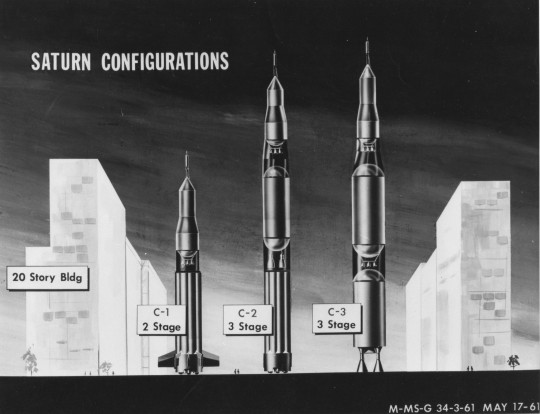
NASA ID: M-MS-G 34-3-61 Date: May 17, 1961
These proving tests would be followed by Apollo A manned earth orbit space laboratory missions in the 1965-1967 period. Manned circumlunar flights would occur at the same time. The booster for such missions was originally intended to be the Saturn C-2. This was changed to the Saturn C-3 in June 1961 when it became clear the Apollo spacecraft would weigh too much for such missions. The C-3 in turn was cancelled in favor of the C-5, and discussion of circumlunar Apollo disappeared by the end of 1962."
-Information from Astronautix.com: link
NASA ID: link
source
#Apollo A#Apollo Phase A#Saturn I#Saturn I Block II#Rocket#NASA#Apollo Program#stay#study#Phase A#1961#Apollo-A#my post
27 notes
·
View notes
Text
What are exoplanets, and how do we detect them?
Post #16 in Physics and Astronomy, 14/01/2023
Welcome back,
First of all: what are exoplanets?
An exoplanet, by definition, is a planet outside our solar system that usually orbits another star within the galaxy. The exoplanets we’ve discovered so far have all been in relatively close proximity, due to limitations in the range of today’s telescopes.
You may have heard of Proxima Centauri b, the exoplanet closest to Earth, resting 4.2 lightyears away from us. Described by NASA as “a potential rocky world, larger than Earth,” it’s kind of a big deal, since it boosts evidence that planets in habitable zones* exist, and are probably quite close to us. We don’t know, however, if the planet has an atmosphere.
*habitable zone: a distance at which temperatures are right for liquid water. Also referred to as the ‘Goldilocks zone.’
How do we detect exoplanets?
There are a number of techniques used by scientists to detect exoplanets, but the two main ones are the transit and radial velocity methods.
Transit: when a planet passes exactly between us and a star it orbits, some of the light provided by the star is blocked. The blockage may be miniscule, nearly imperceptible, but it is still there. It’s just about enough for astronomers to realise that there may be an exoplanet orbiting a star.
Radial velocity: when planets orbit stars, the stars tend to “wobble” a little, i.e. they have an extremely small orbit of their own. This “wobble” changes the colour of light that astronomers see when they observe stars. The light is shifted; if the star is moving in the observer’s direction, it’s shifted to the blue end of the spectrum, and if the star is moving away from the observer, it’ll be red-shifted.
The categories of exoplanets
Gas giants: large planets composed almost entirely of helium and/or hydrogen. Examples familiar to you may include Jupiter or Saturn. Gas giants don’t have hard surfaces; instead, gases swirl above a solid core. However, gas giant exoplanets can be several orders of magnitude larger than Jupiter!
Super-Earths: planets a lot larger than Earth, yet lighter than ice giants like Neptune and Uranus. These can be made of gas, rock, or an arbitrary combination of both. The second closest to us, at the time of writing, is Barnard’s Star b.
Neptunian planets: these are similar to the size of Neptune or Uranus in our solar system. These typically have hydrogen- and helium-filled atmospheres, accompanied by cores of rock and other heavy metals. To date, 1,912 have been discovered, and an example you may recognise is Kepler-1955 b!
Last, but not least, terrestrial planets: examples of these may include Earth, Mars, Mercury, and Venus. For planets outside the solar system, those between half Earth’s size and twice its radius are considered terrestrial. Some rocky exoplanets twice the size of Earth could be terrestrial, but they can also be considered super-Earths. The number of confirmed discoveries for terrestrial planets is a lot lower than Neptune-like planets: we currently have 199!
***
In case you're interested in exploring exoplanets further, I've included a range of NASA web pages so you can do so!
#studyblr#alevels#sixth form#gcse#100 days of productivity#stem#physics#engineering#a levels 2025#astronomy#exoplanets#astrophysics#astrophotography#space#space blog#i love physics#stars#cosmology#astro posts
21 notes
·
View notes
Text
Scientists have confirmed the existence of four small, rocky planets orbiting Barnard's Star — the second closest star system to Earth — using a specialized instrument on the mighty Gemini North telescope in Hawaii. Just six light-years away from us, all the worlds are too hot to support life as we know it. ... The innermost planet in the system is planet d (the planets are named in order of discovery, not distance from the star), which has a mass just 26% that of Earth's and orbits Barnard's Star every 2.34 days at a distance of 1.7 million miles (2.8 million kilometers/0.0188 astronomical units). Next up is planet b: the planet first identified in the ESPRESSO data in 2024. This planet has a mass 30% that of Earth's, and orbits its star every 3.15 days at a distance of 2.13 million miles (3.4 million kilometers/0.0229 AU). Planet c is the heavyweight of the bunch, with a mass 33.5% that of Earth's. It orbits Barnard's Star at a distance of 2.55 million miles (4.1 million kilometers/0.0274 AU) and has an orbital period of 4.12 days. The first three planets were confirmed using just the MAROON-X observations. To confirm the fourth planet, e, the MAROON-X data had to be combined with ESPRESSO's measurements to reveal a planet with just 19% of Earth's mass, orbiting Barnard's Star every 6.74 days at a distance of 3.56 million miles (5.7 million kilometers/0.0381 AU). These worlds are incredibly compact in terms of distance to one another, with just 372,820 miles (600,000 kilometers) between planets d and b, and 434,960 miles (700,000 kilometers) between b and c. For comparison, the mean distance between Earth and our moon is just 238,600 miles (384,000 kilometers). Imagine having a planet on our doorstep at just twice that distance! ... A red dwarf like Barnard's Star is very different to our sun, however. It has just 16% of our sun's mass, and 19% its diameter. ... Red dwarfs can also be very volatile, spewing clouds of charged particles and flares of radiation more frequently than our sun does, which could strip nearby worlds of their atmospheres. However, red dwarf activity does decrease with age, and the Barnard's Star system is about 10 billion years old. That said, none of the planets found so far would be habitable to life as we know it anyway, since they are too close and too hot. Instead, the habitable zone around Barnard's Star would coincide with worlds farther out, with orbital periods of between 10 and 42 days. So far, no planets have been found that far out from the star. "With the current dataset, we can confidently rule out any planets more massive than 40 to 60% of Earth's mass near the inner and outer edges of the habitable zone," sBasant said.. "Additionally, we can exclude the presence of Earth-mass planets with orbital periods of up to a few years. We are also confident that the system does not host a gas giant within reasonable distances." MAROON-X was able to gather 112 radial velocity measurements of Barnard's Star throughout the period 2021–2023. Meanwhile, ESPRESSO has recorded 149 radial velocity measurements of the fleet-footed but diminutive star. This isn't enough to completely rule out the possibility of any more small planets that might be lurking in the habitable zone.
More in linked article.
Interesting how small these planets are. Proxima Centauri b also looks not very big (minimum mass 1.07 Earth masses, a lot bigger than the Barnard's Star planets but small compared to most known exoplanets and within the ballpark of Sol system terrestrial planets). Present exoplanet-finding techniques are strongly biased toward big planets with short orbits. I suspect we're getting our first look at the kind of planets red dwarf stars usually have.
6 notes
·
View notes
Text
I've uploaded First Astronomical Velocity SPECIAL MEDLEY DISC (第一宇宙速度 SPECIAL MEDLEY DISC) onto the Internet Archive. I've also made a Discogs entry for it! pls enjoy.
I bought a couple of Sonico media recently that I'll upload as well soon.
4 notes
·
View notes
Text



ID: two flags that are nine stripe gradients between pastel pink, pastel cyan, and bright yellow-green. the first flag has a first astronomical velocity logo on it with a white outline. the logo is the letters F A and V in pink, yellow and green in a futuristic triangular font. above is "daiichi uchuu sokudo" in pink kanji and below is "first astronomical velocity" in pink letters. END ID
Firstastrovelocic: A gender related to the (fictional) band First Astronomical Velocity (aka Daiichi Uchuu Sokudo)
Logo made by Gil-Hushpond on deviantart, found here (link)
Taglist: @lewdmail-gender @rabidslutboy @apocalypth @mmogaiafterdark @sireneess @mogaigonewild
#rudeadyet.txt#firstastrovelocic#possible eyestrain#18+ liom#18+ mogai#liom after dark#mogai after dark
11 notes
·
View notes
Text
DO WHITE HOLES EXIST??
Blog#369
Wednesday, January 24th, 2024.
Welcome back,
Most people are familiar with the concept of a black hole: a “hole” or extreme warping in space and time that endlessly devours any matter unfortunate enough to venture close to it. Even light can’t escape the inexorable gravitational influence of a black hole, meaning these spacetime events are completely dark and can only be seen from their effect on surrounding matter.

The same scientific theory that predicted the existence of black holes also predicts the existence of white holes, the opposite of black holes in almost every respect. Whereas black holes are endless takers of matter and energy, white holes (hypothetically) ceaselessly blast energy out into the universe. And since nothing can escape a black hole, nothing should be able to enter a white hole.
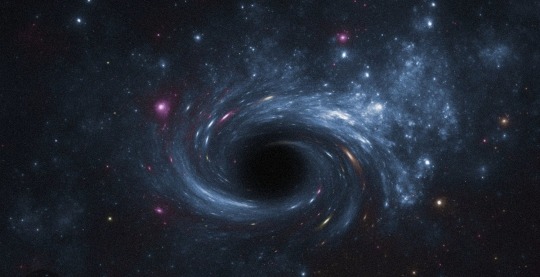
While black holes are tough to spot due to their lack of emissions, white holes should be bright fountains of radiation and, theoretically at least, should be difficult to miss. Yet, so far, astronomers haven’t been able to find any.
But that hasn’t deterred many prominent physicists, such as Italian theoretical physicist and science communicator Carlo Rovelli, from positing their existence. This shouldn’t be too surprising.
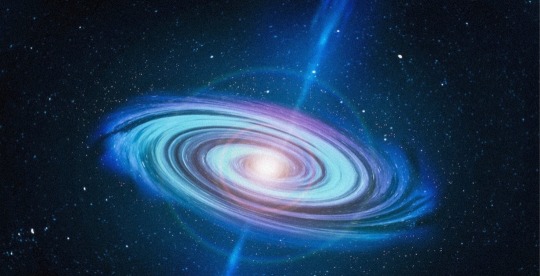
After all, general relativity has a good track record of theoretically predicting aspects of the universe well before they are discovered including black holes, gravitational waves, and the deviation of light known as gravitational lensing (which is used by instruments like the James Webb Space Telescope to see objects in the early universe).
Yet, white holes stubbornly remain the unfulfilled prediction of general relativity

Very simply, a white hole could be considered a black hole that runs backward in time. White holes would have some things in common with black holes: they would possess the characteristics of mass, angular momentum or “spin,” and electric charge.
Like black holes, because they have mass, white holes would attract matter toward them, at least at first.

The difference is that when matter and light pass the event horizon—the point at which the gravity is so strong, the escape velocity exceeds the speed of light—of a black hole, it would never actually be able to reach the “anti-event horizon” of the white hole. It is possible that matter that approaches the anti-event horizon of a white hole could be whipped away with an incredible amount of force.
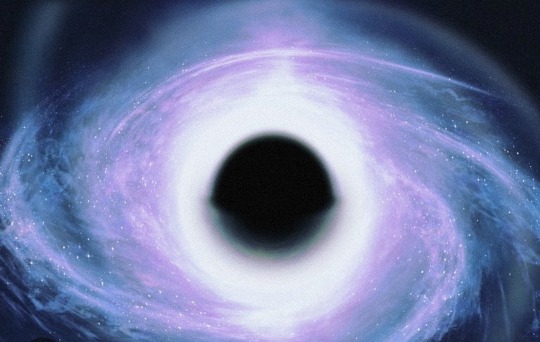
The major difference between black holes and white holes is their formation. We know, thanks to the work of J. Robert Oppenheimer and collaborators, that when a massive star undergoes a complete gravitational collapse at the end of its nuclear fuel-burning life, its outer layers are blasted away in a supernova explosion while its core collapses to birth a black hole.
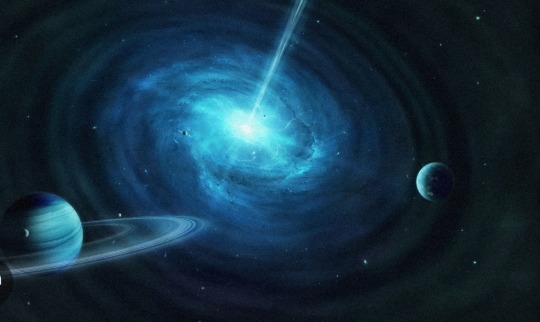
Yet if these death throes could somehow be “rewound” like a cosmic VCR—breaking all the laws of cause and effect in the process—that would not result in a white hole as the mathematics of Kruskal or Novikov surmise. Instead, this cosmic rewind button would just give us back a star on the brink of death.
That means there is actually no physical process in the universe that we know of that could create a white hole.
Originally published on www.popularmechanics.com
COMING UP!!
(Saturday, January 27th, 2024)
"WHAT IS THE 'MOST MYSTERIOUS STAR IN OUR UNIVERSE'??"
#astronomy#outer space#alternate universe#astrophysics#universe#spacecraft#white universe#space#parallel universe#astrophotography
81 notes
·
View notes
Text

NASA’s NICER maps debris from recurring cosmic crashes
For the first time, astronomers have probed the physical environment of repeating X-ray outbursts near monster black holes thanks to data from NASA’s NICER (Neutron star Interior Composition Explorer) and other missions.
Scientists have only recently encountered this class of X-ray flares, called QPEs, or quasi-periodic eruptions. A system astronomers have nicknamed Ansky is the eighth QPE source discovered, and it produces the most energetic outbursts seen to date. Ansky also sets records in terms of timing and duration, with eruptions every 4.5 days or so that last approximately 1.5 days.
“These QPEs are mysterious and intensely interesting phenomena,” said Joheen Chakraborty, a graduate student at the Massachusetts Institute of Technology in Cambridge. “One of the most intriguing aspects is their quasi-periodic nature. We’re still developing the methodologies and frameworks we need to understand what causes QPEs, and Ansky’s unusual properties are helping us improve those tools.”
Ansky’s name comes from ZTF19acnskyy, the moniker of a visible-light outburst seen in 2019. It was located in a galaxy about 300 million light-years away in the constellation Virgo. This event was the first indication that something unusual might be happening.
A paper about Ansky, led by Chakraborty, was published Tuesday in The Astrophysical Journal.
A leading theory suggests that QPEs occur in systems where a relatively low-mass object passes through the disk of gas surrounding a supermassive black hole that holds hundreds of thousands to billions of times the Sun’s mass.
When the lower-mass object punches through the disk, its passage drives out expanding clouds of hot gas that we observe as QPEs in X-rays.
Scientists think the eruptions' quasi-periodicity occurs because the smaller object’s orbit is not perfectly circular and spirals toward the black hole over time. Also, the extreme gravity close to the black hole warps the fabric of space-time, altering the object’s orbits so they don’t close on themselves with each cycle. Scientists’ current understanding suggests the eruptions repeat until the disk disappears or the orbiting object disintegrates, which may take up to a few years.
“Ansky’s extreme properties may be due to the nature of the disk around its supermassive black hole,” said Lorena Hernández-García, an astrophysicist at the Millennium Nucleus on Transversal Research and Technology to Explore Supermassive Black Holes, the Millennium Institute of Astrophysics, and University of Valparaíso in Chile. “In most QPE systems the supermassive black hole likely shreds a passing star, creating a small disk very close to itself. In Ansky’s case, we think the disk is much larger and can involve objects farther away, creating the longer timescales we observe.”
Hernández-García, in addition to being a co-author on Chakraborty’s paper, led the study that discovered Ansky’s QPEs, which was published in April in Nature Astronomy and used data from NICER, NASA’s Neil Gehrels Swift Observatory and Chandra X-ray Observatory, as well as ESA’s (European Space Agency’s) XMM-Newton space telescope.
NICER’s position on the International Space Station allowed it to observe Ansky about 16 times every day from May to July 2024. The frequency of the observations was critical in detecting the X-ray fluctuations that revealed Ansky produces QPEs.
Chakraborty’s team used data from NICER and XMM-Newton to map the rapid evolution of the ejected material driving the observed QPEs in unprecedented detail by studying variations in X-ray intensity during the rise and fall of each eruption.
The researchers found that each impact resulted in about a Jupiter’s worth of mass reaching expansion velocities around 15% of the speed of light.
The NICER telescope’s ability to frequently observe Ansky from the space station and its unique measurement capabilities also made it possible for the team to measure the size and temperature of the roughly spherical bubble of debris as it expanded.
“All NICER’s Ansky observations used in these papers were collected after the instrument experienced a ‘light leak’ in May 2023,” said Zaven Arzoumanian, the mission’s science lead at NASA’s Goddard Space Flight Center in Greenbelt, Maryland. “Even though the leak – which was patched in January – affected the telescope’s observing strategy, NICER was still able to make vital contributions to time domain astronomy, or the study of changes in the cosmos on timescales we can see.”
After the repair, NICER continued observing Ansky to explore how the outbursts have evolved over time. A paper about these results, led by Hernández-García and co-authored by Chakraborty, is under review.
Observational studies of QPEs like Chakraborty’s will also play a key role in preparing the science community for a new era of multimessenger astronomy, which combines measurements using light, elementary particles, and space-time ripples called gravitational waves to better understand objects and events in the universe.
One goal of ESA’s future LISA (Laser Interferometer Space Antenna) mission, in which NASA is a partner, is to study extreme mass-ratio inspirals — or systems where a low-mass object orbits a much more massive one, like Ansky. These systems should emit gravitational waves that are not observable with current facilities. Electromagnetic studies of QPEs will help improve models of those systems ahead of LISA’s anticipated launch in the mid-2030s.
“We’re going to keep observing Ansky for as long as we can,” Chakraborty said. “We’re still in the infancy of understanding QPEs. It’s such an exciting time because there’s so much to learn.”
TOP IMAGE: A system astronomers call Ansky, in the galaxy at the center of this image, is home to a recently discovered series of quasi-periodic eruptions. Credit Sloan Digital Sky Survey
LOWER IMAGE: The NICER (Neutron star Interior Composition Explorer) X-ray telescope is reflected on NASA astronaut and Expedition 72 flight engineer Nick Hague’s spacesuit helmet visor in this high-flying “space-selfie” taken during a spacewalk on Jan. 16, 2025. NASA/Nick Hague

10 notes
·
View notes
Text

The very first scene from Good Omens S2: Angel Crowley in the middle of the cosmic web
A guide to the creation of the universe: from Crowley Starmaker to space missions - part 2
A look at the history of our universe, following the opening scene of the second series of Good Omens.
This analysis was originally written for a very special event that took place last November, which marked a milestone in the history of astronomy! Part 1 here - Read the next part here.
II: Dark matter and dark energy
A discussion on some of universe's intrinsic components - dark matter and dark energy - and the role they play in its expansion.
Returning for a moment to the very first scene of season two, in the image posted here, we see Crowley, in his angelic version, amidst a structure resembling the meshes of a web.
This structure is called the Cosmic Web, and is a trace left by the Big Bang; it not only connects all the galaxies in the universe, but also helps to create them. The Cosmic Web is made up of filaments of hydrogen and dark matter, which we will discuss in a moment; its reticular shape is due to the interaction of gas and dark matter with gravitational forces.
The galaxies that form are also subject to gravitational attraction, which is why they coalesce into larger and larger clusters at the nodes of the cosmic web, where more filaments meet.
WHAT IS THE DARK MATTER?
Everything in our universe is composed of matter, i.e. something that occupies space and has mass. Specifically, ‘normal’ matter, the kind we deal with every day, is composed of atomic particles, i.e. protons, neutrons and electrons, and can exist in a solid, liquid, gaseous or plasma state. We can see it, we can touch it, we can measure various characteristics of it. It is obvious to us that it exists, because we touch it every day or perceive it with instruments, such as telescopes and microscopes. Above all, normal matter can absorb and reflect different frequencies of light. This is the phenomenon at the basis of our perception of colours and allows us to deduce characteristics about celestial bodies far away from us, such as their gradual receding, which has allowed us to elaborate theories on the expansion of the Universe.
Dark' matter, on the other hand, owes its name to the fact that it does not interact with light in any way: it does not reflect it, absorb it or emit it, not at levels measurable by us, at least. But we do know that it has mass and occupies space, thanks to indirect observations.
The first to suggest that galaxies might be made up of something not directly visible was the astronomer Fritz Zwicky, who in the 1930s, while observing the constellation Chioma, noticed a discrepancy between the visible mass and the mass calculated from the velocity of the galaxies within it.
Further evidence came in the 1970s from the astronomer Vera Rubin, who noticed that the stars at the edge of galaxies were moving at the same speed as those at the centre, not slower, as her calculations had suggested. Vera's hypothesis was that galaxies are literally surrounded by a halo of dark matter, so that the distribution of matter within them is uniform.
The observation of gravitational lensing under anomalous conditions also gives us clues to the presence of dark matter. Gravitational lensing occurs when a celestial body is so massive that it exerts a strong gravitational pull that can alter the trajectory of light passing close to it, bending it like an optical lens.
This phenomenon has also been observed in the vicinity of celestial bodies that would not have a mass large enough to produce it, so cosmologists believe that their true masses are far greater than those detected by telescopes.
To date, scientists estimate that the Universe is made up of only 5% normal matter and about 27% dark matter. The remaining 68% would be dark energy.
WHAT IS THE DARK ENERGY?
If we know little about dark matter, we know virtually nothing about dark energy. Its existence is purely theoretical: 'dark energy' is the name given to the force that creates a negative pressure in the universe, causing it to expand at an ever-increasing rate.
Scientists have formulated two hypotheses according to which dark energy could have both a constant density and a density that varies in time and space; it should fill empty space and interact only with the force of gravity. The most common justification among physicists and cosmologists is that it is an energy intrinsic to the physical vacuum: where one exists, the other also exists.
In the next chapter, we're going to continue exploring our Universe. Next stop: the Big Bang.
More infos at:
_ Building Blocks - NASA Science
_ Fritz Zwicky and the Existence of Dark Matter | SciHi Blog
_ Shining a Light on Dark Matter - NASA Science
_ Gravitational lens - Wikipedia
_ Dark matter - Wikipedia
_ Dark energy - Wikipedia
Read this post on AO3
Subscribe to my series: The Nice and Accurate Good Omens Analysis and The Science behind Good Omens
Find me on Facebook
#good omens#good omens s2#good omens s2 spoilers#angel crowley#starmakercrowley#starmaker#nebula#astronomy#space#outer space#good omens science#good omens analysis#stars#angel aziraphale
4 notes
·
View notes
